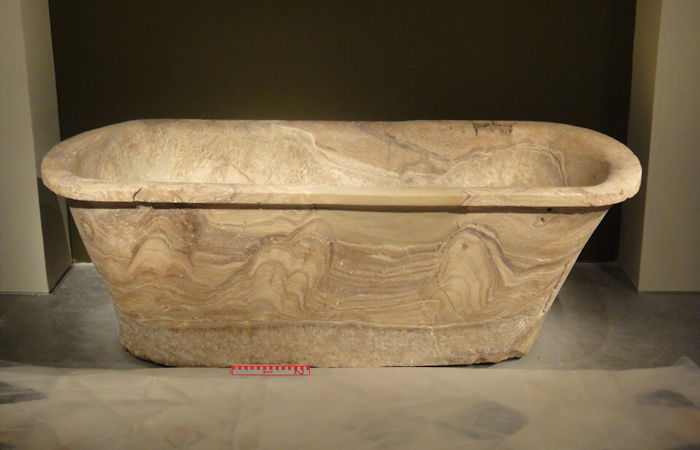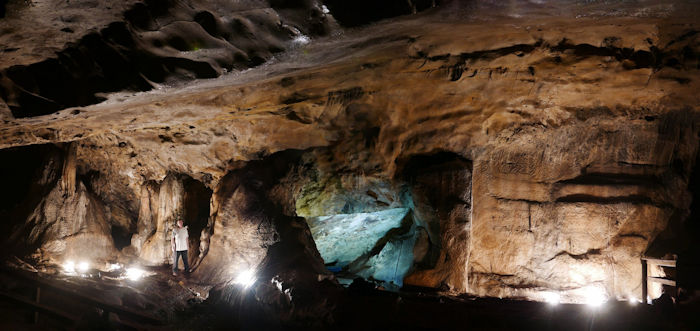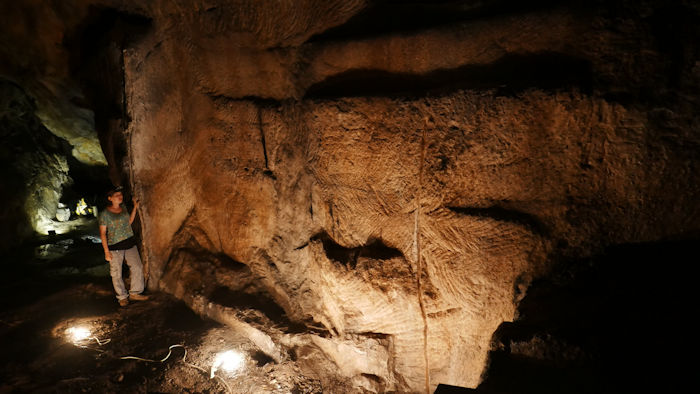Jan Bartek – AncientPages.com – From the Middle Bronze Age, Egypt played a crucial role in the appearance of calcite-alabaster artifacts in Israel, and the development of the local gypsum-alabaster industry. The absence of ancient calcite-alabaster quarries in the Southern Levant (modern day Israel and Palestine) led to the ᴀssumption that all calcite-alabaster vessels found in the Levant originated from Egypt, while poorer quality vessels made of gypsum were local products.

Herod’s calcite-alabaster bathtub found in Kypros fortress. Credit: Prof. Amos Frumkin, The Hebrew University of Jerusalem
Until now this long-held ᴀssumption was never scientifically tested. But the recent identification of a calcite-alabaster quarry in the Te’omim cave, located on the western slopes of the Jerusalem hills (near modern-day Beit Shemesh, Israel), calls this hypothesis into question.
A new study, recently published in the journal Scientific Reports, scientifically refutes the hypothesis and, for the first time, allows the distinction between calcite-alabaster originating in Israel from that originating in Egypt. Furthermore, it confirms that calcite-alabaster objects, such as Herod the Great’s alabaster bathtubs, were quarried in Israel rather than Egypt.
The research was conducted as part of Ayala Amir’s MA thesis at the Martin (Szusz) Department of Land of Israel Studies and Archaeology at Bar-Ilan University in Israel, supervised by Prof. Boaz Zissu and Prof. Aren M. Maeir, of Bar-Ilan University, and Prof. Amos Frumkin, of The Hebrew University of Jerusalem.
Analytical data were first collected from samples of two well-defined sources, from Egypt and modern-day Israel. The Egyptian sources included both ancient and modern calcite-alabaster samples. The ancient samples were obtained courtesy of the Kunsthistorisches Museum in Vienna, Austria. These ancient vessel remains were collected by the Austrian archaeological expedition to Giza in the nineteenth century CE.

Te’omim cave and the quarry on the right. Credit: Ayala Amir, Bar-Ilan University
The modern Egyptian artifact, made of geological-sourced calcite-alabaster, was bought in a market in Cairo, Egypt in 2013. The calcite-alabaster from Israel included raw material from the Te’omim cave quarry, chips (mining debitage) found in the cave near the quarry, and chips and a stone block (raw material carved to a cube, but not yet used to make a vessel) from Umm el-‘Umdan—an archaeological site near the Te’omim cave. Additional samples were collected from a speleothem in Natuf cave located in Wadi en-Natuf in western Samaria.
Next, through a multidisciplinary approach, the calcite-alabaster samples from Israel and Egypt were analyzed with the ᴀssistance of Prof. Gil Goobes and Prof. Amnon Albeck, of the Department of Chemistry at Bar-Ilan University using four analytic methods, most of which have not been previously used, to determine their origin: inductively coupled plasma (ICP) analysis, routine infra-red (IR) spectroscopy, 1H- and 31P- solid state NMR (ssNMR) experiments and C and O stable isotope ratio analysis to determine their composition and their crystalline structure.
“All four analytical methods applied in the study provided consistent results, clearly distinguishing the Israeli from the Egyptian calcite-alabaster for the first time,” said Prof. Albeck of the findings.
The same methods were then applied to two of Herod the Great’s royal bathtubs, which were made of finely worked calcite-alabaster and found in the Kypros fortress and the palace of Herodium, located just south of Jerusalem. The results unequivocally indicated that the bathtubs were quarried in Israel and not in Egypt, the main source of calcite-alabaster in ancient periods.
“The fact that both bathtubs were unequivocally quarried in Israel and not in Egypt, as we would have expected due to the high quality of the stone, was a particular surprise because that means that Herod the Great used local produce, and that the calcite-alabaster industry in Judea in the second half of the first century BC was sufficiently developed and of high enough quality to serve the luxurious standards of Herod, one of the finest builders among the kings of that period,” said Prof. Aren Maeir.

Researcher Ayala Amir beside the wall of the quarry, signs of quarrying-scars and cessation of quarrying are visible on the quarry’s walls and floor. Credit: Prof. Boaz Zissu, Bar-Ilan University
The source of calcite-alabaster artifacts cannot be determined by traditional archaeological methods. Furthermore, petrographic analysis, the main method used to determine the source of Israeli calcite-alabaster, shows wide variability in texture, depending on its depositional environment. Consequently, this method could not be used to identify the source of the bathtubs.
“The multidisciplinary approach adopted in this study provides information concerning both the composition and crystalline structure of calcite-alabaster and is significant for understanding and interpreting archaeological findings,” said researcher Ayala Amir. “Combining analytic methods with archaeological studies may provide new and fascinating information that could not be obtained by traditional archaeological techniques and enable us to determine the origin of other calcite-alabaster artifacts with much greater confidence,” she added.
The study was published in the journal Scientific Reports
Written by Jan Bartek – AncientPages.com Staff Writer





